Dear Fellow Dreamer,
I grew up a mile and a half from Lake Ontario, one of the largest freshwater bodies on the earth. Was I aware of it? Barely. In our low-rise suburban neighbourhood, our back hedge bordered the shrunken plot of an old farmhouse, half tree-hidden on a crescent of post-war bungalows. Like other vestigial structures I passed on my bike, searching their stark window-eyes for ghosts, the farmhouse had remained from the days of market garden agriculture—a slim stratum of time paved over in drives, winding side streets, and courts. Glen this. Glen that. Below Berry Road with its strip malls and trawling bus, sprawled more 1950s tract housing, occasionally dotted with century cottages and fairytale-tiny frame cabins. From our south-facing bathroom window, upstairs in our storey-and-a-half home—beyond all of it, on clear days—I spied a thin blue strip of water.
That the lake was too polluted to swim in and “almost dead” was simply an environmental detail I learned, along with other local geography: the landfill-field beyond our cul-de-sac, toboggan hills, my school, two parks with swings, the library, the churches, the public pool, my friends’ homes, the cemetery, the corner plaza, and how to bike to the wildest place I knew—the Humber River—where the land and water seemed to speak.
When I walked down Park Lawn Road, as I often did, to get to Humber Bay Library, I could see the densely trafficked Queensway and glimpse the industrial lands farther south. From a passenger seat in my family’s Ford Granada, I also knew how the road kept going beneath the Gardiner Expressway to a seedy Lakeshore Boulevard motel strip and the Palace Pier condominium tower—a sky-scraping solo harbinger of the condo canyon yet to come. Then, of course, blue water.
In my early twenties, at a cocktail party hosted by friends of a friend’s parents, I met financially wealthy men whose Mississauga companies dumped toxic waste into the lake—something I asked them about, before the subject quickly changed. During that same mid-‘80s period, while learning to sail in Toronto’s Inner Harbour, one of our tests was to capsize our dinghies and right them. Afterward, on my wet skin, hair, and clothes lingered the smell of gasoline.
Yet now, forty years on, due to greater environmental awareness and activism—public engagement, government efforts, and technological advancements—Lake Ontario is generally safe to enter again. And neighbouring Lake Erie, once declared “dead” in the 1960s, has been restored to a swimmable state. Does that mean it’s now “alive”? Hold that question.
Another River Runs Through It
I lived in Toronto’s Cabbagetown district from late in 1988 to early in 1997. There, the nearest river was the Don, a place where I found restoration, as I’d once done at the Humber. A young mother, wife, and teacher, in my few solo hours, I often walked with a notebook and paused among the reeds on the riverbank, and dreamed. I didn’t fully realize it at the time, but during those days I was seeding stories and poems. Books. I wouldn’t write them for years, yet the valley spoke to me. In the late 1990s and early aughts, though I’d moved on, whenever I could, I travelled back to those Cabbagetown streets and into the river valley, connecting with its energies and tending those inner seeds.
When I say the location “spoke” to me, I don’t just mean figuratively—because I sensed that there, somehow, ideas and stories were being transmitted. Don’t ask me to explain it. In Riverdale Park and in the valley, I sketched old trees and communed with them. It’s a delicate thing, being attuned to a tree—the waves are subtle at the heart. It takes reverence and practice and stillness. If you’re a tree person, then you know. If not, and you’d like to be, give communing with a tree a try. Ask a question and see what comes. You won’t be wasting your time. In some ways, Toronto’s lower Don River and its valley became the most formative geography of my life—a life that, when compared with the river’s millennia-old existence, is but a raindrop.
I love the wilds of the Don Valley—persistent blooms in the ruins of industrial sites reclaimed by nature after decades of degradation. When I first started walking there, some part of me knew I needed to reimagine my life. But I wasn’t ready. I believe the river, along with its clay banks, grasses, rocks, wildflowers, and trees helped me to dream.
Others were dreaming, too. And they were daring to do so publicly. Between 1989 and 2010, the Task Force to Bring Back the Don was a citizen advisory committee created to guide Toronto’s City Council on matters affecting the health of both the river and the Don’s watershed. The objectives? Clean up the mess, restore marshlands, protect the water, land, and air. The wildlife. Make the area accessible. To this day, river advocates still work on the Don’s behalf. The work shows. A few years ago, on a return trip to the city, my husband and I were amazed by the transformation of the lower Don where multi-unit living spaces now exist alongside parkland and river flora. Native plants have been brought back and people can easily walk among them, surrounded by a flourishing beauty.

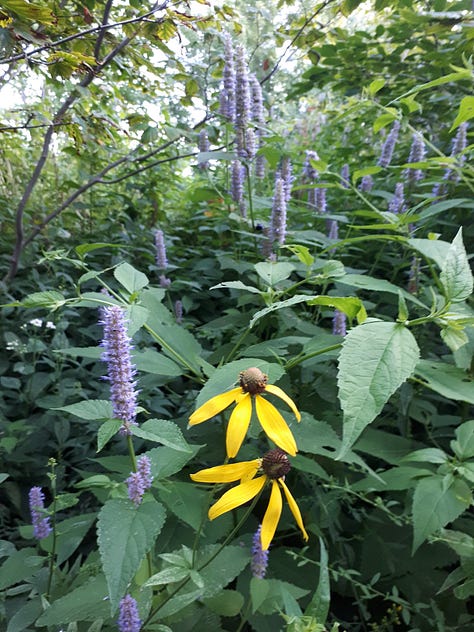
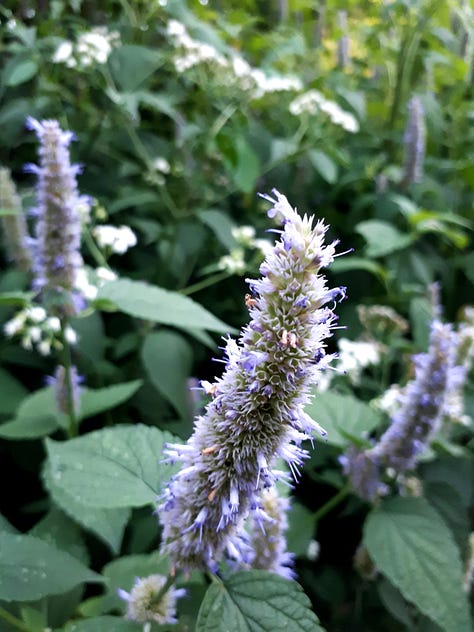
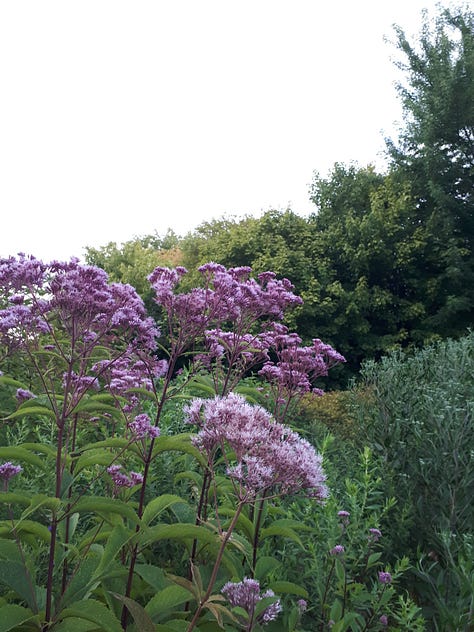
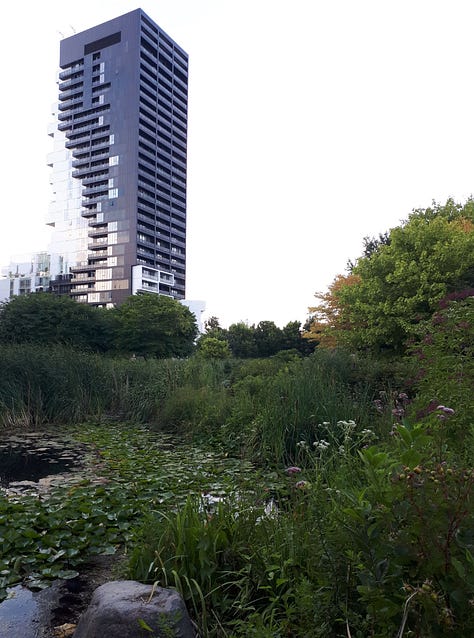
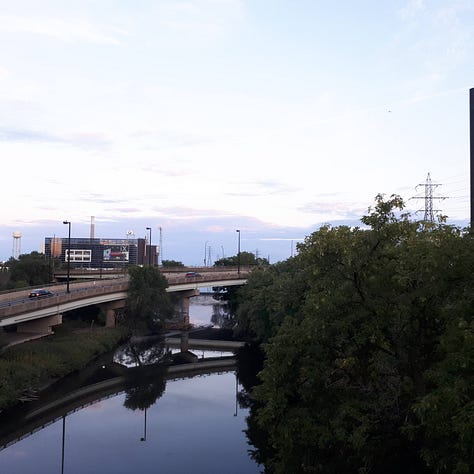
Is it perfect? Well, actually—no. Far from it. The Don River still suffers from the effects of heavy pollution due to sewage and stormwater runoff. Yet the task force and its surviving river keepers have made significant progress. But is that enough?
Without clean water, we wouldn’t be here. Neither would most plants—and plants have been here much longer. In her book, Braiding Sweetgrass, Indigenous author Robin Wall Kimmerer emphasizes that plants and animals are not just resources to be exploited, but also “our oldest teachers,” offering valuable lessons. Her work calls us to acknowledge, re-story, and celebrate “our reciprocal relationship with the rest of the living world.” She explores how Indigenous knowledge and scientific understanding can help us do that. If you haven’t read Braiding Sweetgrass, I assure you that it’s an important, gorgeous piece of writing—one I’m reading now and recommend. In my recent studies with herbalist Robin Rose Bennett, echoing Kimmerer and other Indigenous teachers, Bennett stresses that plants are helpers. We can ask for their help.
Another thought to hold.
Is a River Alive?
One of the many things I took away from author Rob Macfarlane’s recent interview at the Ottawa International Writers Festival (OIWF), was his emphasis on the word “reimagine.” His latest book, Is a River Alive? is a call to reimagine our whole relationship with nature. In this new work, Macfarlane recounts several of his own life-altering journeys to rivers, river people, and river ideas significant in the context of the rapidly emerging Rights of Nature movement—one that recognizes a river as a living entity. While speaking with OIWF host David McGuffin, Macfarlane explained that at the heart of the movement is “the idea that rivers, forests, mountains should have their rights recognized—not bestowed, recognized—as having always existed.” Moreover, Rights of Nature advocates insist that the state should be a guarantor of those rights. Macfarlane stresses his latest work is “an exploration, not a declaration” of that position. The question in his book’s title is not rhetorical, but a sincere invitation to wonder and reflect. It’s an appeal not only to expand our knowledge of rivers and the natural world, but our ways of knowing.
Is a River Alive? probes four vastly different riverscapes, each with their own distinct ecosystems: an imperilled chalk-stream a mile from Macfarlane’s Cambridge, UK home; the Río Los Cedros, or River of the Cedars, in an Ecuadoran cloud-forest; various wounded waterways of India, including the Adyar River; and the Mutehekau Shipu or Magpie River, flowing south from the boreal forest in northeastern Québec. “In each place,” Macfarlane told us in Ottawa, “rivers are being radically reimagined away from just the resource model.” The three places he travelled to were under severe threat—by mining in the cloud-forest, by pollution in India, and in Canada, by damming. Reading of the Mutehekau Shipu taught me how, through hydro-electric damming, a river can actually be drowned—something that happened with Québec’s Romaine River, now the Mutehekau Shipu’s “ghost sister.”
In part, Macfarlane’s book is an examination of “how rationalism has fully subordinated rivers to use value, ‘thing’ value…” Thus, Is a River Alive? is not only a rigorously researched exploration of the science of rivers and their ecosystems (in and of itself a poetic and fascinating dimension of the book), but of ravagements to those ecosystems by massive new technologies and human processes.
“We are titanic in our powers—but I think our sense of responsibility and imagination to the more-than-human world has not kept pace with those titanic powers.” —Robert Macfarlane
At the heart of his work is a vital theme: We must not give up hope for our world; and hope is a discipline—it requires persistent action. With that in mind, Macfarlane chronicles recent victories by environmental protection groups. In 2008, for example, after a national referendum, Ecuador made a change to its constitution that was a global first. In Is a River Alive? its author quotes and summarizes key passages of Articles 71 to 74, known as the Rights of Nature articles in the revised charter:
“’Nature, or Pacha Mama, where life is reproduced and occurs,’ states the first of these, ‘has the right to integral respect for its existence and for the maintenance and regeneration of its life cycles, structure, functions and evolutionary processes.’ The other three articles recognize nature’s right to be restored when damaged, the relationship between the good health of nature and the ‘good living’ (sumak kawsay) of humans, and the obligation upon the state to restrict activities that might lead ‘to the extinction of species, the destruction of ecosystems and the permanent alteration of natural cycles…’”
Macfarlane also describes how, in 2018, in my (now) home province of Québec, the Mutehekau Shipu narrowly escaped being triple-killed by a proposed multi-dam complex after a protective alliance was formed by four groups—Indigenous and settler, governmental and grassroots alike. In telling the story, he explains a term coined by the Mi’kmaq Elders Albert and Murdena Marshall of Eskasoni First Nation: Two-Eyed Seeing. “The two eyes in the Marshalls’ image are Indigenous and Western ways of knowing, focusing together.” Modern scientific knowledge combined with traditional ecological knowledge, “seeking mutual enhancement rather than opposition.”
As a result—and similar to how, after years of decolonizing efforts, the Māori People and the Crown in Aotearoa New Zealand worked together to ensure that the Whanganui River is now legally regarded as a person and a living being—in Canada, thanks to Two-Eyed Seeing, the Mutehekau Shipu is now recognized as “‘a legal person with the right to live,’ and as the bearer of other attendant rights including the rights ‘to exist and to flow,’ and ‘to evolve naturally, to be preserved and protected.’”
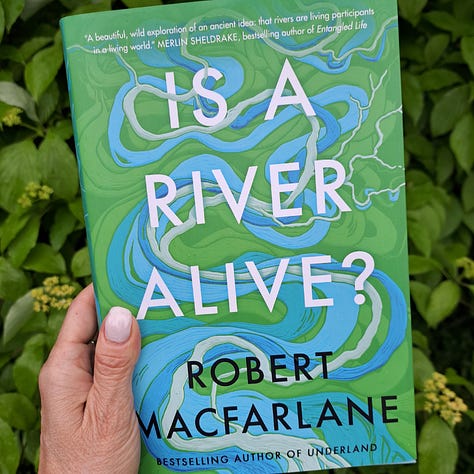

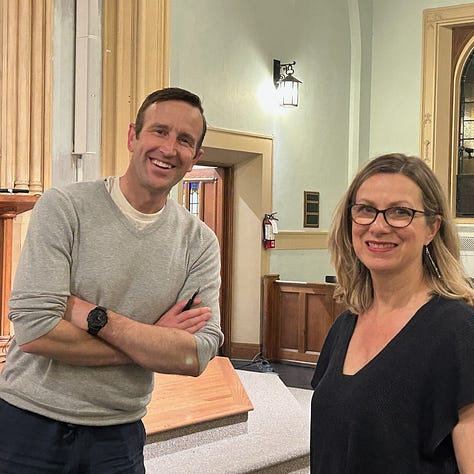
The last thing I’ll say about Is a River Alive? —beyond recommending you read it—is that I love Macfarlane’s stories of the brilliant, committed, complex, and heart-led river people he meets, each on their own journey within a journey. There are too many to recount here, but I’ll touch upon a few. There’s Guiliana Furci in the Ecuadoran cloud-forest who, by some supernormal gift, can locate fungi growing on the forest floor with her sense of hearing. In Chennai, India, there’s Yuvan Aves, a 26-year-old survivor of severe trauma, who “has somehow become a young man dedicated to healing both rivers and people.” For me, a highlight was reading of Innu poet, activist, and healer, Rita Mestokosho, who instructed Macfarlane and his travelling companion, Wayne Chambliss, on how to be with the Mutehekau Shipu as they paddled it and camped—how to show the river respect and create conditions for inviting and receiving knowledge. In his account of his own inner and outer journeying, Macfarlane opens himself to the river as a spiritual entity—one with the ability to bring insights, answers, and healing. At a certain point he knows he “must surrender agency to this incomprehensible presence.” And he insists that while travelling the mighty Mutehekau Shipu, the river helped him write the book.
A Few Final Questions
1. How well do you know your nearest river? And that river’s watershed? Its headwaters? A few years ago I was asked those questions, not on any ecological tour, but in a workshop devoted to environmental activism and poetry. I could answer for the rivers where I grew up: both the Humber and the Don flow down to Lake Ontario from the Oak Ridges Moraine—an area environmentalists continue to monitor, fight for, and protect from the hands of developers. However, I had to research the watersheds of both the Gatineau and Ottawa Rivers, now so close to me.
2. Why is it important to get to know your nearest river and watershed? I leave that to your reflection. In the spirit of Awakening Wonder, I also wonder how, together, as a society, we may get better at Two-Eyed Seeing.
3. Where is the border between imagination and intuition? That question dwells in me everyday. I don’t feel a need to answer it so much as to “live into” the question and see where it takes me. I’m comfortable with mystery. What about you?
4. Finally, as we learn to develop our ability to reimagine, what new stories are we capable of inviting and writing—co-writing—for a better world?
Quote of the Week:
“Action on behalf of life transforms. Because the relationship between self and the world is reciprocal, it is not a question of first getting enlightened or saved and then acting. As we work to heal the earth, the earth heals us.”
―Robin Wall Kimmerer
Looking Back and Ahead:
Last week marked the one-year anniversary of Awakening Wonder. Thank you for being here! For reading, listening, writing your thoughts, and sharing these letters with others. Your presence means so much. As we move into summer, I have decided to do some personal reimagining. Specifically, I will be taking time to nurture a couple of newer, long-haul writing projects, as well as my own sense of harmony in work and life. While I remain open for transformational life coaching (simply contact me), throughout the months of July and August, I’ll be slowing the pace when it comes to creating posts. Once we near September, I’ll pick it up again. I love this dedicated space where we can think together and dream. It’s hard to believe it’s been a year. I look forward to our next one here!
For readers in the Ottawa-Gatineau area, I’ll be selling my books at the Ottawa Small Press Book Fair this Saturday, June 21st, from 12 – 5 p.m. It’s always a great event, and I hope to see you there.
Look for my next newsletter toward the end of July.
Happy solstice.

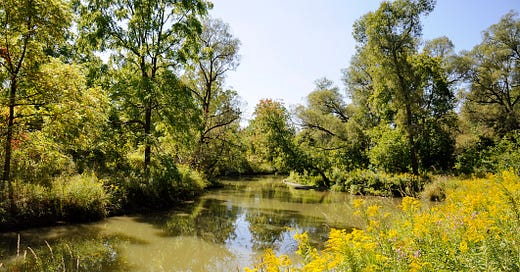





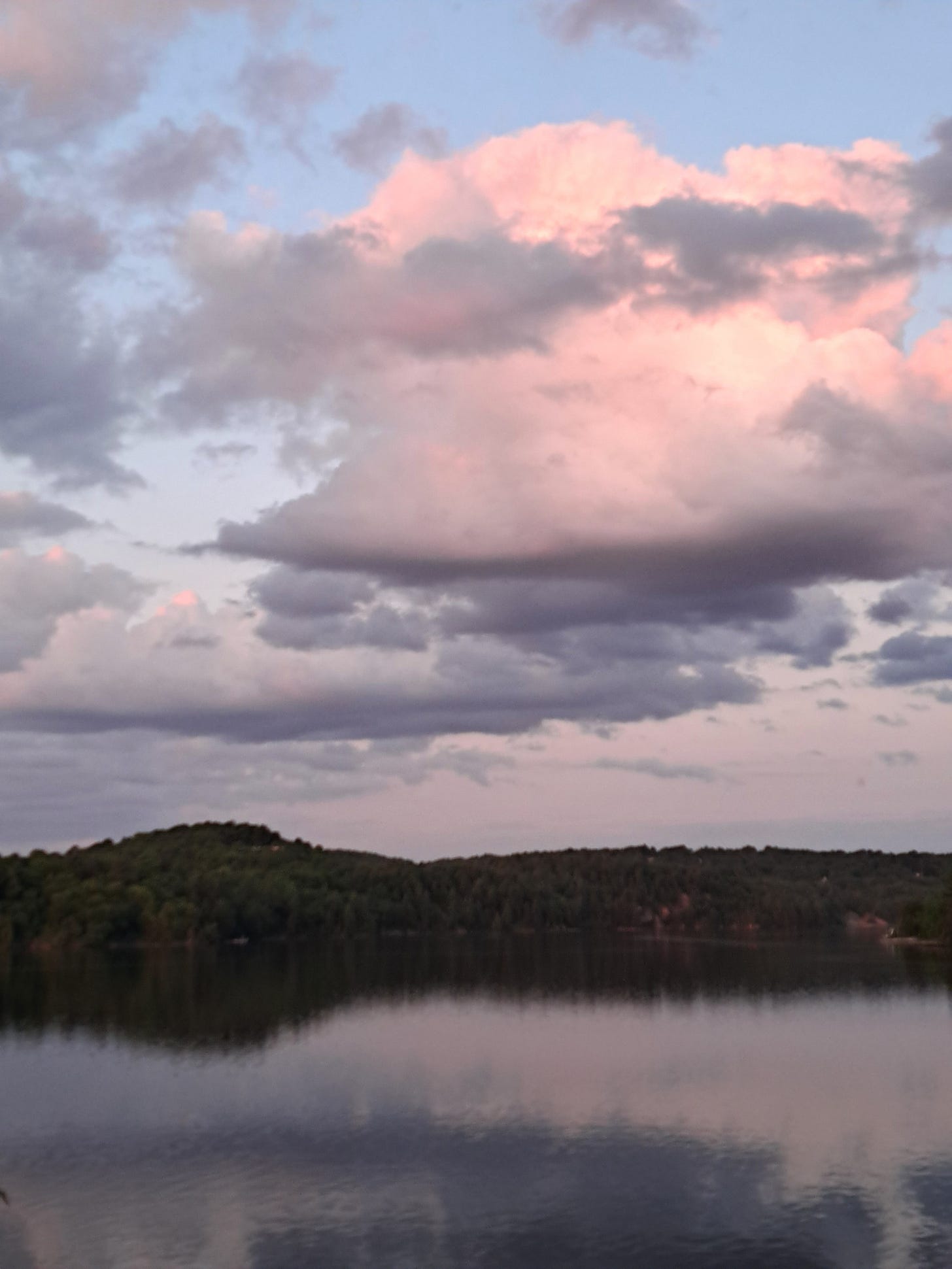

P. S. If you’re looking for some environmental good news, here’s Robert Macfarlane’s recent op-ed on the de-damming and subsequent revitalization of the USA’s Klamath River: “Rivers are easily wounded, but given a chance, they revive with remarkable speed. Lazarus-like, their life pours back. The first salmon was detected swimming upstream of where the Klamath dams had once stood just three days after the completion of the dams’ removal last September. Within a month, 6,000 salmon had migrated up into the newly accessible habitat.”
https://www.nytimes.com/2025/05/30/opinion/river-clean-water-act-klamath.html
Hello Robin, I had to come back to this post. You have provided a landscape that takes us to the river beneath the river, which I call our ancient earth soul — as Clarissa Pinkola Estes speaks about.
Your question—“Is a river alive?”—landed in my chest like a prayer.
Amazing similarity. I grew up near Lake Erie and Lake Ontario too, and I remember when we could Not enter the murky waters, when the water turned from companion to caution. Even then, something in me knew the water was still alive—wounded, yes, but listening, asking for our care.
Thank you for invoking Robin Wall Kimmerer’s wisdom. I’m reading and listening to Braiding Sweetgrass again slowly, like a ceremony. I also hear Robin Rose Bennett’s voice in your words—yes, plants as helpers. They are intimate, powerful kin that I continuously learn to be in right relationship with.
Water too. Maybe they’ve been waiting for us to remember that aliveness doesn’t mean perfection—it means relationship.
I will look up your recommendations.
This piece stirred memory, grief, and a kind of hopeful ache. Another thought to hold, indeed.
Thank you for putting this together so beautifully—your writing is a gift.